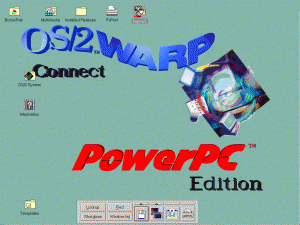 | |
| Developer | IBM |
|---|---|
| Written in | C, C++ |
| OS family | Universal |
| Working state | Discontinued |
| Source model | Closed source, Mach open source |
| Released to manufacturing | December 15, 1995[1] |
| Final release | None |
| Final preview | OS/2 Warp Connect (PowerPC Edition) 1.0 / January 5, 1996[1] |
| Marketing target | Global |
| Available in | English |
| Platforms | PowerPC |
| Kernel type | Microkernel |
| Default user interface | Workplace Shell |
| Preceded by | OS/2, AIX |
| Succeeded by | OS/2, AIX |
| Articles in the series | |
| AIM alliance, Taligent, PowerPC | |
Workplace OS is IBM's ultimate operating system prototype of the 1990s. It is the product of an exploratory research program in 1991 which yielded a design called the Grand Unifying Theory of Systems (GUTS), proposing to unify the world's systems as generalized "personalities" cohabitating concurrently upon a universally sophisticated platform of object-oriented frameworks upon one microkernel. Using personalities, a single machine would be able to run applications from multiple conventional operating systems like Unix or OS/2.
Developed in collaboration with Taligent and its Pink operating system imported from Apple via the AIM alliance, the ambitious Workplace OS was intended to improve software portability and maintenance costs by aggressively recruiting all operating system vendors to convert their products into Workplace OS personalities. In 1995, IBM reported that "Nearly 20 corporations, universities, and research institutes worldwide have licensed the microkernel, laying the foundation for a completely open microkernel standard." At the core of IBM's new unified strategic direction for the entire company, the project was intended also as a bellwether toward PowerPC hardware platforms, to compete with the Wintel duopoly.
With protracted development spanning four years and $2 billion (or 0.6% of IBM's revenue for that period), the project suffered development hell characterized by workplace politics, feature creep, and the second-system effect. Many idealistic key assumptions made by IBM architects about software complexity and system performance were never tested until far too late in development, and found to be infeasible. In January 1996, the first and only commercial preview was billed under the OS/2 family with the name "OS/2 Warp Connect (PowerPC Edition)" for limited special order by select IBM customers, as a crippled product. The entire Workplace OS platform was discontinued in March due to very low market demand, including that for enterprise PowerPC hardware.
A University of California case study described the Workplace OS project as "one of the most significant operating systems software investments of all time" and "one of the largest operating system failures in modern times".
